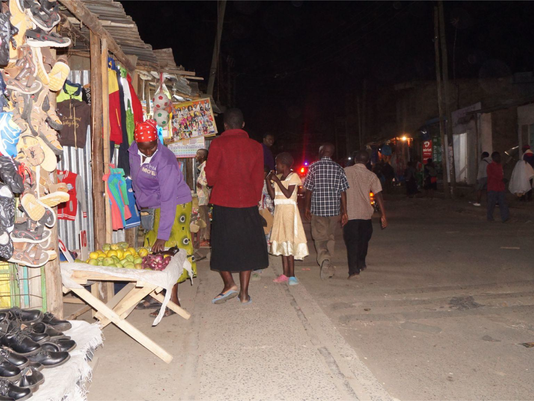Tactic 08: Public lighting

.png)


In the last decade, a section of Kenya’s informal settlements have benefited from significant upgrading investment. This has been coupled with infrastructure investment in other amenities such as water, sewerage, roads, and housing. Public lighting and sustainable lighting options are regarded as a neglected topic, and lighting is a key factor in facilitating pedestrian movement at night as well as promotion of outdoor night activities (Nadel ,2022). However, the importance of lighting goes beyond that of safety and security. Lighting in informal settlements is required in homes, public spaces, productive spaces, and transitional spaces.
The Challenge
While lighting alone as an intervention may not address all the issues and use in informal settlements, its value is significant. It helps addressing and mitigating challenges such as:

Access: Absence of lighting impacts residents' safe and secure access to shelter and public amenities such as washrooms, parks, etc after sunset. 86% of impacts of the lighting project under the Kenya Informal Settlements Improvement Project (KISIP) were related to security (including reduction in gender-based violence and increase in safe mobility).
Uneven lightning: In Kenya, informal settlements are primarily lit by 30m high-mast lighting structures. Despite their importance and wide use, high mast lighting has been reported to create uneven lighting: they cast shadows in constricted spaces and shed too much light in open spaces (Makumbe et al. 2016).
Crime and insecurity: A strong body of evidence links poor public lighting in informal settlements to high levels of crime and insecurity and as such many productive activities in informal settlements stop before nightfall (Kenya Power and Lighting, 2014).
Income generation: After sunset, muggings are common and people want to avoid moving around in the dark. This affects people’s businesses and their possibility of generating income in the evening/night. Furthermore, informal settlement residents service the formal city, where they may represent up to half of the workforce (Dovey and Kamalipour, 2018); inadequate lighting may affect their daily commute to work.
Public lighting systems are continuously evaluated for effectiveness and adaptability, incorporating feedback to address challenges such as uneven lighting and maintenance issues.
The implementation of well-distributed lighting enhances the community's capacity to mitigate risks such as crime and accidents, fostering a safer environment and supporting swift recovery from disruptions.
The approach prioritizes collaboration with residents as equal stakeholders, using their insights to design lighting systems that address localized safety and accessibility challenges.
By implementing sustainable lighting solutions, the tactic respects community values, minimizes ecological impact, and protects biodiversity through low-impact, energy-efficient systems.
The public lighting tactic ensures inclusive participation by involving residents in identifying unsafe areas and mapping the needs of the settlement, promoting equitable access to safe spaces.
Street-led design approach: A design approach which takes the user’s experience and needs into consideration, oftentimes focusing on accessibility, safety, user-focused and community interactions, all in which can be enhanced through public lighting.
Safe navigation: The urban morphology of most informal settlements is composed of haphazard structures with irregular paths between them. Public lighting promotes safe navigation across physical hazards such as sewer systems, waterways and the narrow accesses between shelters.
Well-designed lighting: Public lighting that is designed to promote the safety of all road and public space users, which include pedestrians and cyclists, not only motor vehicle drivers. On streets, lighting should illuminate pedestrian space, cyclist paths and carriageways to reduce risk of accidents and improve personal security. Special attention should be given to marginalized groups, such as women and children, to ensure their safe and secure access to public spaces after sunset.
Key concepts
How To
System of lighting
Well-designed street lighting enables motor vehicle drivers, cyclists, and pedestrians to move safely and comfortably by reducing the risk of traffic crashes and improving personal security.
-
Street lighting is of key consideration for infrastructure upgrading which is often “street-led”. Engage communities in the mapping and design processes to understand which areas are the most exposed to crimes and violence, as well as structurally haphazardous areas.
-
Explore alternative lighting systems that can be used instead, to avoid uneven intense lighting and shadow casting, and remain low-cost and resilient to vandalism.
-
Additionally, improve public lighting in spaces designated for walking and cycling, to create a more safe and secure environment for pedestrians. Aim to design a system of lighting throughout the whole neighborhood, that connects public spaces with more private and residential areas, to ensure even lighting.
Case Studies
References
https://avsi-usa.org/wp-content/uploads/2020/03/AVSI-_-COELBA3.pdf
https://www.iajournals.org/articles/iajispm_v3_i6_245_260.pdf
African Journal of Business Management - predictors of effective change management: a literature review
https://nadel.ethz.ch/news0/news/2022/01/impact-of-public-lighting.html
iajispm_v3_i6_245_260.pdf
Kenya Power & Lighting Company Limited (KPLC.ke) 2014 Annual Report
High-mast lighting as an adequate way of lighting pedestrian paths in informal settlements? - ScienceDirect
Street Design Manual for Urban Areas in Kenya – Institute for Transportation and Development Policy
http://www.adopt-a-light.com/slum_lighting.php
Home | Kenya Informal Settlements Improvement Project (KISIP)
https://avsi-usa.org/wp-content/uploads/2020/03/AVSI-_-COELBA3.pdf
https://www.iajournals.org/articles/iajispm_v3_i6_245_260.pdf
Further Reading
Case 1: Adopt a light slum Lighting project
Its objective was that of lighting public spaces in informal settlements in Nairobi in order to improve security and make them safer for residents.
Partners: “Adopt a light”, NCCG, Kenyan parliament , private sector companies and target settlement communities.
http://www.adopt-a-light.com/slum_lighting.php
Case 2
A total of 33 high mast lighting were installed in Kibera, Mathare, Korogocho, Hruma, Kawangware and Kangemi, serving 500,000 people in 150 households
https://avsi-usa.org/wp-content/uploads/2020/03/AVSI-_-COELBA3.pdf
Case 3
Project outcome:- In addition to improving neighbourhood security, an evaluation by Ipsos synovate kenyan Ltd concluded that the project provided a conducive environment for productive economic activities resulting from extended business hours(Un-Habitat, 2015).
factors influencing sustainability of public street light development ...










